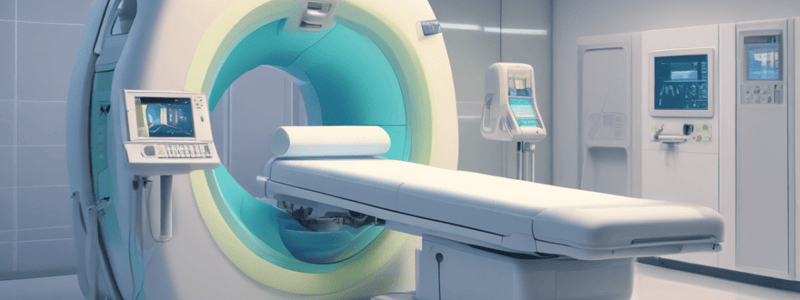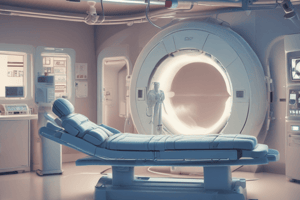Podcast
Questions and Answers
What is the primary purpose of the imaging system in a CT scanner?
What is the primary purpose of the imaging system in a CT scanner?
- Display, record, and store the x-ray images
- Produce x-rays and detect radiation passing through a defined cross-section (correct)
- Maintain the computer system for data processing
- Control the operation of the gantry components
Where is the computer system typically located in a CT scanner setup?
Where is the computer system typically located in a CT scanner setup?
- Scanner room
- Operator's room
- Computer room (correct)
- Filter room
Which component is responsible for X-ray production in the imaging system of a CT scanner?
Which component is responsible for X-ray production in the imaging system of a CT scanner?
- Detectors
- Collimators
- Filter
- X-ray tube and generator (correct)
What role do collimators play in the imaging system of a CT scanner?
What role do collimators play in the imaging system of a CT scanner?
Which room houses the display, recording, and storage system in a CT scanner setup?
Which room houses the display, recording, and storage system in a CT scanner setup?
What do detectors do in the imaging system of a CT scanner?
What do detectors do in the imaging system of a CT scanner?
Which component is responsible for ensuring beam uniformity at the detectors in a CT scanner?
Which component is responsible for ensuring beam uniformity at the detectors in a CT scanner?
What is the primary purpose of the liquid-bearing technology used in the Straton X-ray tube?
What is the primary purpose of the liquid-bearing technology used in the Straton X-ray tube?
What is the key advantage of the Straton X-ray tube's compact design?
What is the key advantage of the Straton X-ray tube's compact design?
What is the significance of the Straton X-ray tube's electron beam being deflected to strike the anode at two precisely located focal spots?
What is the significance of the Straton X-ray tube's electron beam being deflected to strike the anode at two precisely located focal spots?
What is the significance of the Straton X-ray tube being encased in a protective housing that contains oil for cooling?
What is the significance of the Straton X-ray tube being encased in a protective housing that contains oil for cooling?
What is the primary reason for the increased cooling rates in the Straton X-ray tube compared to conventional X-ray tubes?
What is the primary reason for the increased cooling rates in the Straton X-ray tube compared to conventional X-ray tubes?
What is the significance of the Straton X-ray tube's ability to be used in high kV and high mA techniques for prolonged durations?
What is the significance of the Straton X-ray tube's ability to be used in high kV and high mA techniques for prolonged durations?
What is a key factor that determines the radiation source requirement in CT?
What is a key factor that determines the radiation source requirement in CT?
Why have rotating anode X-ray tubes become common in CT?
Why have rotating anode X-ray tubes become common in CT?
What material is commonly used in the disk of rotating anode X-ray tubes to meet spatial resolution requirements?
What material is commonly used in the disk of rotating anode X-ray tubes to meet spatial resolution requirements?
Why are metal envelope tubes preferred over glass envelope tubes in x-ray tubes?
Why are metal envelope tubes preferred over glass envelope tubes in x-ray tubes?
What is a key feature of the cathode assembly in x-ray tubes?
What is a key feature of the cathode assembly in x-ray tubes?
What type of anode disk design is mostly used in tubes for spiral/helical CT scanning?
What type of anode disk design is mostly used in tubes for spiral/helical CT scanning?
What is the purpose of the bearing assembly in x-ray tubes?
What is the purpose of the bearing assembly in x-ray tubes?
What type of liquid is used in the liquid-bearing method to improve rotation in modern CT?
What type of liquid is used in the liquid-bearing method to improve rotation in modern CT?
What feature allows metal envelope tubes to use higher tube currents compared to conventional tubes?
What feature allows metal envelope tubes to use higher tube currents compared to conventional tubes?
How do brazed graphite disks increase heat-storage capacity compared to all-metal disks?
How do brazed graphite disks increase heat-storage capacity compared to all-metal disks?
What is the function of the internal laser in a CT scanner?
What is the function of the internal laser in a CT scanner?
What is the purpose of the high-frequency generator in a CT scanner?
What is the purpose of the high-frequency generator in a CT scanner?
What is the main function of the gantry in a CT scanner?
What is the main function of the gantry in a CT scanner?
Which component helps to identify the scan plane in a CT scanner?
Which component helps to identify the scan plane in a CT scanner?
What is the purpose of the wall-mounted laser in a CT scanner?
What is the purpose of the wall-mounted laser in a CT scanner?
Why do most scanners have a 70-cm aperture according to the text?
Why do most scanners have a 70-cm aperture according to the text?
What does the gantry tilting range refer to in a CT scanner?
What does the gantry tilting range refer to in a CT scanner?
Where is the high-frequency generator located in most modern CT scanners?
Where is the high-frequency generator located in most modern CT scanners?
Flashcards are hidden until you start studying
Study Notes
CT Scanner Components and Functions
- The primary purpose of the imaging system in a CT scanner is to produce images.
- The computer system is typically located in a separate room, which houses the display, recording, and storage system.
X-ray Production and Beam Uniformity
- The X-ray tube is responsible for X-ray production in the imaging system of a CT scanner.
- Collimators play a role in shaping the X-ray beam.
- The X-ray tube's beam uniformity is ensured by the X-ray beam filter.
Detector Functions
- Detectors convert X-ray signals into electrical signals.
Straton X-ray Tube
- The primary purpose of the liquid-bearing technology used in the Straton X-ray tube is to improve cooling rates.
- The Straton X-ray tube's compact design allows for a smaller footprint and increased portability.
- The electron beam is deflected to strike the anode at two precisely located focal spots, ensuring beam uniformity.
- The Straton X-ray tube is encased in a protective housing that contains oil for cooling, allowing for increased cooling rates.
- The Straton X-ray tube can be used in high kV and high mA techniques for prolonged durations due to its efficient cooling.
Radiation Source Requirements
- The radiation source requirement in CT is determined by the type of examination and the patient's size.
Rotating Anode X-ray Tubes
- Rotating anode X-ray tubes have become common in CT due to their high heat capacity and ability to handle high X-ray tube currents.
- Molybdenum is commonly used in the disk of rotating anode X-ray tubes to meet spatial resolution requirements.
- Metal envelope tubes are preferred over glass envelope tubes in X-ray tubes due to their strength and durability.
Cathode Assembly and Anode Disk Design
- A key feature of the cathode assembly in X-ray tubes is its ability to produce a high-intensity electron beam.
- The spiral/helical anode disk design is mostly used in tubes for spiral/helical CT scanning.
Bearing Assembly and Liquid-Bearing Method
- The bearing assembly in X-ray tubes allows for smooth rotation of the anode.
- Oil is used in the liquid-bearing method to improve rotation in modern CT.
Brazed Graphite Disks and Metal Envelope Tubes
- Brazed graphite disks increase heat-storage capacity compared to all-metal disks due to their high thermal conductivity.
- Metal envelope tubes can use higher tube currents compared to conventional tubes due to their strength and durability.
CT Scanner Components and Functions
- The internal laser in a CT scanner helps to identify the scan plane.
- The high-frequency generator in a CT scanner produces the high voltage needed for X-ray production.
- The gantry in a CT scanner holds the X-ray tube and detectors, and allows for rotation and tilting.
- The wall-mounted laser in a CT scanner helps to identify the scan plane.
- Most scanners have a 70-cm aperture to accommodate a wide range of patient sizes.
- The gantry tilting range refers to the ability of the gantry to tilt to different angles.
- The high-frequency generator is located in a separate room in most modern CT scanners.
Studying That Suits You
Use AI to generate personalized quizzes and flashcards to suit your learning preferences.




